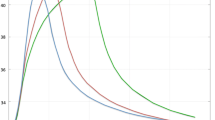Abstract
Studies of thermal sensation in man commonly use a 7 point category scale. Such scales have disadvantages, and an experiment was carried out to apply the methods of the new psychophysics to whole body thermal sensation. Ten sedentary subjects were exposed singly to a temperature To near their comfort level, then to (To + 3) and (To −3)°C. The subject responded both by giving a warmth vote, and by gripping a dynamometer so that the strength of his grip was equal to his thermal sensation: this is the method of cross modality matching. For each subject the strength of grip was consistently related to thermal sensation vote, but the range of grips employed by different subjects was very high, making between subjects comparison impossible. The experiment was repeated with the subjects unclothed and heavily clothed. No effect of clothing was found on the rate of change of thermal sensation with temperature; conventional theories which relate sensation to heat load would predict a factor of 2.
Similar content being viewed by others
References
BEDFORD, T. (1936): The Warmth Factor in Comfort at Work. Rep. Industr. Hlth. Res. Bd., No. 76, London.
EYSENCK, H.J. (1958): A short questionnaire for the measurement of two dimensions of personality. J. appl. Psychol., 42: 14–17.
EYSENCK, H.J. (ed.)(1971): Bearings on Basic Psychological Processes. Readings in Extraversion-Introversion. Vol. 3, Staples Press, London.
FANGER, P.O. (1972): Thermal Comfort. McGraw-Hill, New York.
GRIFFITHS, I.D. and BOYCE, P.R. (1971): Performance and thermal comfort. Ergonomics, 14: 457–468.
KJERULF-JENSEN, P., NISHI, Y., FANGER, P.O. and GAGGE, A.P. (1975): A test chamber design for investigating man's thermal comfort and physiological response. ASHRAE TRANS., 81 (I): 73–82.
McINTYRE, D.A. (1975): The determination of individual preferred temperatures. ASHRAE TRANS., 81 (II): 131–139.
MILLER, G.A. (1956): The magical number seven, plus or minus two. Psychol. Rev., 63: 81–97.
NISHI, Y., GONZALEZ, R.R. and GAGGE, A.P. (1975): Direct measurement of clothing heat transfer properties during sensible and insensible heat exchange with the thermal environment. ASHRAE TRANS., 81 (II): 183–199.
SPRAGUE, C.H. and MUNSON, D.M. (1974): A composite ensemble method for estimating thermal insulating values of clothing. ASHRAE TRANS., 80 (I): 120–129.
STEVENS, J.C. and MACK, J.D. (1959): Scales of apparent force. J. exp. Psychol., 58: 405–413.
STEVENS, J.C., MARKS, L.E. and GAGGE, A.P. (1969): The quantitative assessment of thermal discomfort. Env. Res., 2: 149–165.
WINER, B.J. (1971): Statistical Principles in Experimental Design. (2nd ed.) McGraw-Hill, New York.
WYON, D.P., BRUUN, N.O., OLESEN, S., KJERULF-JENSEN, P. and FANGER, P.O. (1971): Factors affecting the subjective tolerance of ambient temperature swings. 5th International Conference for Heating, Ventilating and Air Conditioning, Copenhagen. Vol. I: 87–107.
YAGLOU, C.P. (1927): The comfort zone for men stripped to the waist. J. indust. Hyg., 9: 251–260.
Author information
Authors and Affiliations
Rights and permissions
About this article
Cite this article
McIntyre, D.A. Thermal sensation. A comparison of rating scales and cross modality matching. Int J Biometeorol 20, 295–303 (1976). https://doi.org/10.1007/BF01553586
Received:
Issue Date:
DOI: https://doi.org/10.1007/BF01553586




